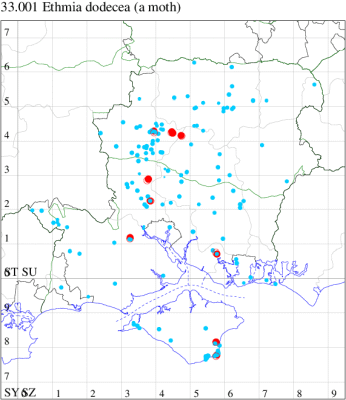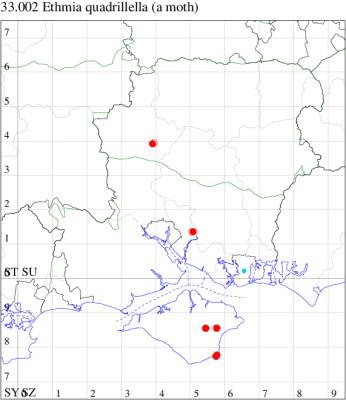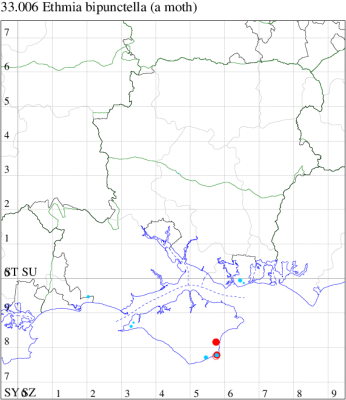2020 Annual Report for: Ethmiidae / Ethmiinae
For species seen in 2020 that had less than or equal to 100 records, full details are included; for more common species, the earliest, latest and highest count by vice-county are shown. The narrative for each species is taken from the main Hantsmoths website, and it is possible that some information on abundance and occurrence can get out of date, as it is impossible to keep up with all changes; however it should give a good introduction to each species. The tables in each species account summarise the previous status, and that for the current year.
For the maps, all records prior to 2020 are shown by a blue dot (the larger the dot, the more recent), with the current year's records shown in red. As previous records are superimposed on any report for 2020, new sites have greater emphasis (i.e. will show as 'more red').
In the species accounts, an asterisk next to a location indicates a new 10km square record; earliest ever dates are highlighted in orange, and latest ever in red. Initials in the species accounts refer to the recorders listed here. Please get in touch if you identify any omissions or errors, in particular if you have records that have yet to be submitted. Details of how to submit records can be found here.
33.001 [B&F: 0718] Ethmia dodecea (Haworth, 1828) - Local
Local in woodland rides, fens and scrubland across much of southern England. In Hampshire still reasonably common along the M3 corridor from Chandler's Ford to Basingstoke, but rare elsewhere in the county and on the Isle of Wight. Wingspan 17-21 mm. The pattern of large spots on a pure white ground precludes confusion with other Ethmia species and the superficially similar Yponomeuta, as well as the much larger Thistle Ermine Myelois circumvoluta. Larva feeds on Common Gromwell, living within a silken web, and over-wintering as a pupa.
Records prior to 2020
| Vice County | #Records | #Individuals | First Record | Last Record |
|---|---|---|---|---|
| 10 | 102 | 178 | 1989 | 2019 |
| 11 | 94 | 135 | 1980 | 2019 |
| 12 | 183 | 311 | 1971 | 2019 |
2020 records
| Vice County | #Records | #Individuals | Max Quantity |
|---|---|---|---|
| 10 | 5 | 6 | 2 |
| 11 | 6 | 5 | 1 |
| 12 | 6 | 8 | 3 |

Records by year
Records by week (adult)
Records by week (larval)
Record Details
VC10: Bonchurch, one, 26 May; one, 22 Jun; one, 24 Jun; two, 25 Jun (JHa); Shanklin, one, 25 Jun (IOu);
VC11: Woodlands, New Forest, present, 23 Jun (RBW); Kings Somborne, one, to actinic, 11 Jun; one, to actinic, 09 Jul; one, to actinic, 11 Jun (GCE); Romsey, one, 25 Jun (NRJ); Fareham, one, 25 Jun (KJW);
VC12: Harewood Forest, one, to actinic, 24 Jun; Barton Stacey, one, to actinic, 16 Jul; three, to actinic, 08 Jun; one, to actinic, 08 Jun; one, to actinic, 08 Jun; Wonston , one, to actinic, 17 Jul (GCE)
33.002 [B&F: 0719] Ethmia quadrillella (Goeze, 1783) - Nationally Scarce B
Nationally scarce (Nb) in fens, marshes, damp woodland, waste ground, gardens and on river-banks in England, as far north as Westmorland and Cumberland, but absent from south-west England and Wales (MBGBI Vol 4 part 1). First recorded in Hampshire in 2012, with another in 2018: however 2020 saw a record seven individuals, including the first for VC12 and the Isle of Wight, and it looks set to be a species that will increase in numbers annually. Wingspan 15-19 mm. Larva feeds on shoots and leaves of Common Comfrey, Tuberous Comfrey, Lungwort and Common Gromwell, beneath a silken web, over-wintering as a pupa.
Records prior to 2020
| Vice County | #Records | #Individuals | First Record | Last Record |
|---|---|---|---|---|
| 11 | 2 | 2 | 2012 | 2018 |
2020 records
| Vice County | #Records | #Individuals | Max Quantity |
|---|---|---|---|
| 10 | 5 | 6 | 2 |
| 11 | 1 | 1 | 1 |
| 12 | 1 | 1 | 1 |

Records by year
Records by week (adult)
Records by week (larval)
Record Details
VC10: New Vice-county Record: Wheelers Bay*, one, 08 Aug (ABu); Bonchurch*, one, 08 Aug; one, 09 Aug (JHa); Haseley Manor*, two, 11 Aug (IOu); Alverstone to Newchurch cycle path*, one, field observation, 08 Jun (RAsha);
VC11: Botley*, one, to actinic, 13 Aug (SLB);
VC12: New Vice-county Record: Chilbolton*, one, to actinic, 09 Aug (SLE det. GCE)
33.006 [B&F: 0720] Ethmia bipunctella (Fabricius, 1775) - Nationally Scarce B
Nationally scarce (Nb) on shingle beaches in parts of south-eastern England, mostly on the coast from east Kent to east Sussex, but also in the majority of the counties south of a line from the Bristol Channel to The Wash, inland records are perhaps the result of immigration. In Hampshire a very scarce species on the coast, with only one inland record, at Winchester in 1990. On the Isle of Wight, recorded for the first time at Freshwater in 1996, with another close-by in 2003 and sporadically since. Wingspan 18-28 mm. Larva feeds on Viper's Bugloss, living between flowers and leaves spun together with silk, over-wintering as a pupa.
Records prior to 2020
| Vice County | #Records | #Individuals | First Record | Last Record |
|---|---|---|---|---|
| 10 | 5 | 5 | 1996 | 2018 |
| 11 | 6 | 6 | 1983 | 2013 |
2020 records
| Vice County | #Records | #Individuals | Max Quantity |
|---|---|---|---|
| 10 | 3 | 3 | 1 |

Records by year
Records by week (adult)
Records by week (larval)
Record Details
VC10: Bonchurch, one, 20 Jun (JHa); Shanklin*, one, 25 Jun; one, 01 Jul (IOu)

